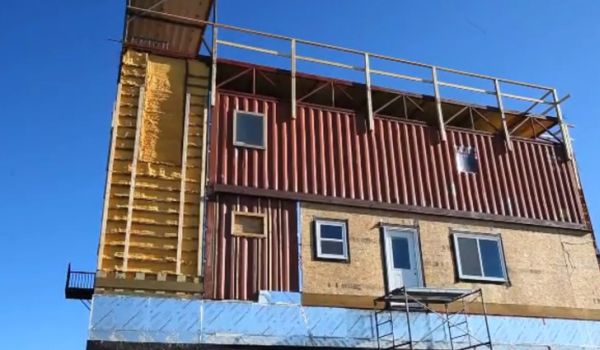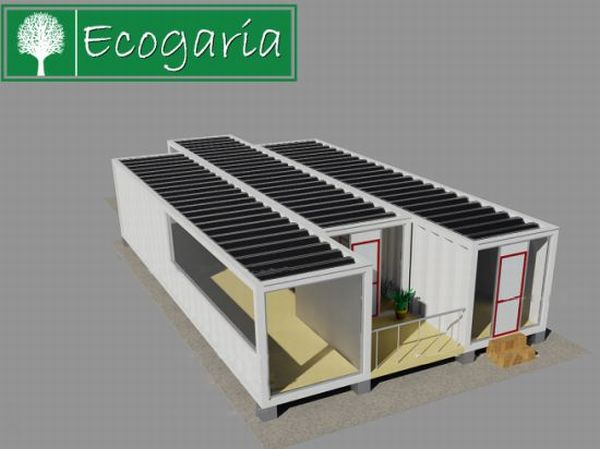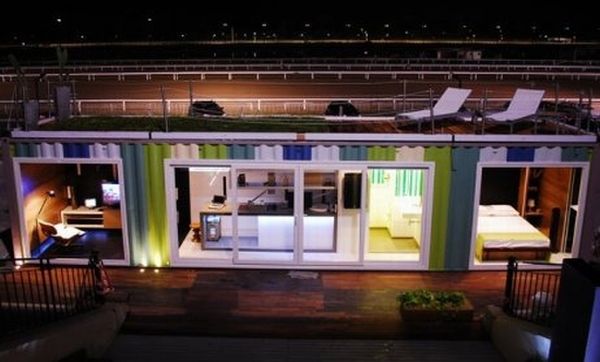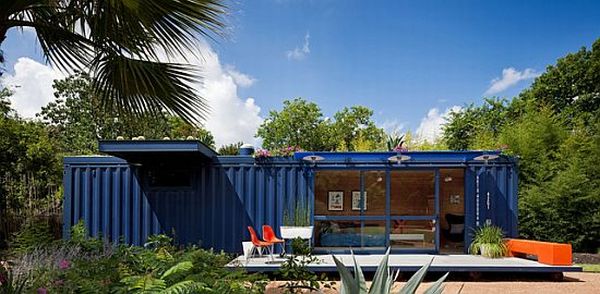
The concept
A Canadian couple, Bill and Roseanne Glennon, are building their dream home from 30 recycled shipping containers. The under-construction sea-can home has generated much interest among designers as well as tourists visiting the area. However, Calgary-based Glennon family is not the first to have done so. In recent times, many other designers have also experimented with this idea, as you will see below. Shipping containers are strong, economically sound and structurally suitable for building unique models of futuristic and self-sufficient houses. They provide ample space and a basic house structure to designers to come up with a unique model.
Also, as compared to conventional building materials, shipping containers can be purchased at low cost for using as mainframe of the house. Other details like covering the outer walls with stucco for a conventional look, insulating exteriors from heat and cold and arranging renewable sources for powering the house could be completed accordingly.
The Inspiration
Building a home is always a dream for couples. But, for Calgary-based Bill and Rosseane Glennon, it was a bit more elaborate. They wanted a large home under the budget of $1 million. After years of touring show homes and checking in the market, all they could realize that the kind of home they want might take a fortune. However, a newspaper article about a home made from shipping containers gave them hope. Bill Glennon applied his scaffolding and carpentering experience to design a model home from recycled shipping containers and started the construction in 2009.
The Sea-can house has been built from 30 shipping containers. Each container weighs around 5,000 kg and has the load capacity of about 30,390 kg. The containers have been stacked to form the mainframe of a four-story building having two levels above the ground, a walkout basement and one level below. The design includes plan for four bedrooms, five bathrooms, games and media room, garage, workshop and two enclosed decks for the building spread in 5,000-square-foot area. It has also been planned to keep the new home free from power grids by using wind and solar systems for generating power for the home. Besides, there will be a large garden surrounding the building in the eight-acre-property.
Eco credentials
The sea-can house has been designed to be free from dependence on conventional power sources. It will not be connected to local power grid. Instead, it will completely depend on solar and wind energy for power. For this energy-efficient windows, a wind generator and 4.8-kw solar system has been installed. The wooden interior walls will be insulated from both inside and outside so that it will require less power for heating during winters. Also, little power will be required for heating since a large part of the home is underground. The couple has also planned for installing solar water heater.
Feasibility
Shipping containers form a unique building material. They are strong and feasible material for building homes. Also, it could be purchased at an affordable price. The Glennon family purchased 30 containers for $ 3,000 each. And, the estimated cost of their house is expected to be about $125 per square foot. This cost is certainly very less as compared to rates of urban houses these days.
Related trends:
1. Ecogaria shipping container home gets powered by solar energy

Designed by Omar Aponte, the Ecogaria is another model of an eco friendly house made from recycled shipping containers. It will depend on solar energy for power. For this, the model features solar panels mounted on the roof of the house. Aponte has kept the design of this eco friendly house flexible. This will allow the users to modify it as per their needs.
2. Shipping container home by Verde es Bueno

Designers at Verde es Bueno have built a luxury model of home made from recycled shipping containers. The design shows how shipping containers could be creatively transformed into luxury abodes with little effort. The house features four spaces composed of living rooms, kitchen and bedroom. The bedroom also contains a hidden office below a retractable bed and a wardrobe inside one of the walls. Bonded leather and wood obtained from sustainably maintained forests have been used for covering the surface of the house.
Built originally for interior design exhibition at Casa FOA, the prefab luxury model also features eco friendly measures such as solar panels for supplying a part of energy need of the house. Also, it has been properly insulated for reducing the consumption of energy for heating and cooling the house.
3. Sustainable shipping container home by Jim Poteet

Architect Jim Poteet has created this shipping container-based model of home for Stacey Hill in Texas. Made from a 40-foot shipping container, it could be used as a playhouse, a garden retreat or a guesthouse. Like other such homes discussed above, this model also features many environment friendly measures. Pottet has employed many methods for ensuring low consumption of energy. As such, large floor to ceiling glass doors and windows have been used for receiving more sunlight inside the house.
The house also features green roof with solar panels, heating and air conditioning system, a small sink, shower and a composting toilet. Interestingly, the entire structure of this environment friendly house is placed on a base made from recycled telephone poles. Also, bamboo has been used for flooring and covering the walls. The owner intends to use this model house as a sustainable prototype for the development of an artist’s studio in future.

